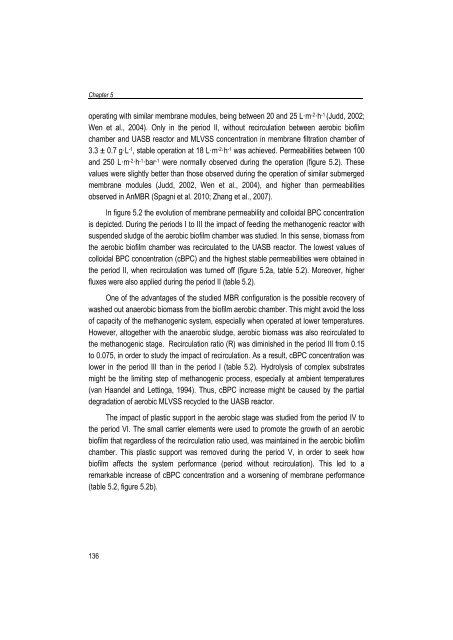Combining submerged membrane technology with anaerobic and ...
Combining submerged membrane technology with anaerobic and ...
Combining submerged membrane technology with anaerobic and ...
You also want an ePaper? Increase the reach of your titles
YUMPU automatically turns print PDFs into web optimized ePapers that Google loves.
Chapter 5operating <strong>with</strong> similar <strong>membrane</strong> modules, being between 20 <strong>and</strong> 25 L·m -2·h -1 (Judd, 2002;Wen et al., 2004). Only in the period II, <strong>with</strong>out recirculation between aerobic biofilmchamber <strong>and</strong> UASB reactor <strong>and</strong> MLVSS concentration in <strong>membrane</strong> filtration chamber of3.3 ± 0.7 g·L -1 , stable operation at 18 L·m -2·h -1 was achieved. Permeabilities between 100<strong>and</strong> 250 L·m -2·h -1·bar -1 were normally observed during the operation (figure 5.2). Thesevalues were slightly better than those observed during the operation of similar <strong>submerged</strong><strong>membrane</strong> modules (Judd, 2002, Wen et al., 2004), <strong>and</strong> higher than permeabilitiesobserved in AnMBR (Spagni et al. 2010; Zhang et al., 2007).In figure 5.2 the evolution of <strong>membrane</strong> permeability <strong>and</strong> colloidal BPC concentrationis depicted. During the periods I to III the impact of feeding the methanogenic reactor <strong>with</strong>suspended sludge of the aerobic biofilm chamber was studied. In this sense, biomass fromthe aerobic biofilm chamber was recirculated to the UASB reactor. The lowest values ofcolloidal BPC concentration (cBPC) <strong>and</strong> the highest stable permeabilities were obtained inthe period II, when recirculation was turned off (figure 5.2a, table 5.2). Moreover, higherfluxes were also applied during the period II (table 5.2).One of the advantages of the studied MBR configuration is the possible recovery ofwashed out <strong>anaerobic</strong> biomass from the biofilm aerobic chamber. This might avoid the lossof capacity of the methanogenic system, especially when operated at lower temperatures.However, altogether <strong>with</strong> the <strong>anaerobic</strong> sludge, aerobic biomass was also recirculated tothe methanogenic stage. Recirculation ratio (R) was diminished in the period III from 0.15to 0.075, in order to study the impact of recirculation. As a result, cBPC concentration waslower in the period III than in the period I (table 5.2). Hydrolysis of complex substratesmight be the limiting step of methanogenic process, especially at ambient temperatures(van Ha<strong>and</strong>el <strong>and</strong> Lettinga, 1994). Thus, cBPC increase might be caused by the partialdegradation of aerobic MLVSS recycled to the UASB reactor.The impact of plastic support in the aerobic stage was studied from the period IV tothe period VI. The small carrier elements were used to promote the growth of an aerobicbiofilm that regardless of the recirculation ratio used, was maintained in the aerobic biofilmchamber. This plastic support was removed during the period V, in order to seek howbiofilm affects the system performance (period <strong>with</strong>out recirculation). This led to aremarkable increase of cBPC concentration <strong>and</strong> a worsening of <strong>membrane</strong> performance(table 5.2, figure 5.2b).136
















